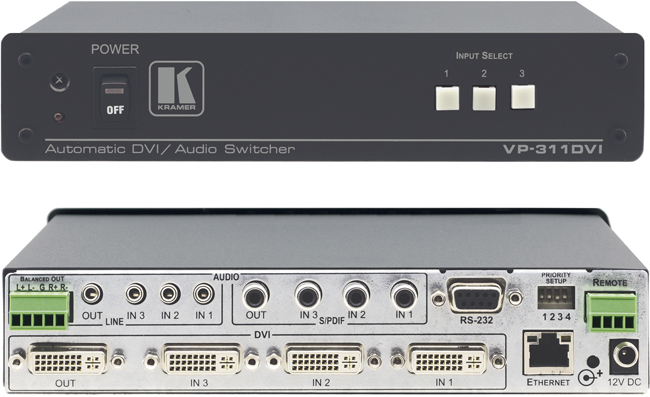DVI or Digital Visual Interfaces is a video display interface developed by the Digital Display Working Group (DDWG). The digital interface is used to connect a video source, such as a display controller to a display device, such as a computer monitor. It was developed with the intention of creating an industry standard for the transfer of digital video content.
The interface is designed to transmit uncompressed digital video and can be configured to support multiple modes such as DVI-D (digital only), DVI-A (analog only), or DVI-I (digital and analog). Featuring support for analog connections, the DVI specification is compatible with the VGA interface. This compatibility, along with other advantages, led to its widespread acceptance over competing digital display standards Plug and Display (P&D) and Digital Flat Panel (DFP). Although DVI is predominantly associated with computers, it is sometimes used in other consumer electronics such as television sets, video game consoles, and DVD players.
DVI cables can transmit uncompressed digital video through different modes including DVD-D (digital only), DVI-A (analog only), or DVI-I (digital and analog). In many cases, A DVI cable can run up to 50ft without losing digital quality, otherwise a DVI extender may be needed for your application for runs over 50ft. DVI cables can be found in many applications including home theaters, hospitals, residences, restaurants, bars and many more. In general, cable lengths up to 15 feet (4.6 m) will work for display resolutions up to 1920 × 1200. Longer cables up to 50 feet (15 m) in length can be used with display resolutions 1280 × 1024 or lower. For greater distances, the use of a DVI booster – a signal repeater which may use an external power supply – is recommended to help mitigate signal degradation.

The DVI connector on a device is given one of three names, depending on which signals it implements:
- DVI-I (integrated, combines digital and analog in the same connector; digital may be single or dual link)
- Single link at 24 bits or less per pixel, and dual link at between 25 and 48 bits inclusively per pixel up to 1920 × 1200
- Dual link or DVI-DL at 24 bits or less per pixel up to 2560 × 1600
- DVI-D (digital only, single link or dual link)
- Single link at 24 bits or less per pixel, and dual link at between 25 and 48 bits inclusively per pixel up to 1920 × 1200
- Dual link or DVI-DL at 24 bits or less per pixel up to 2560 × 1600
- DVI-A (analog only) Since the analog pins are directly compatible with VGA signaling, passive adapters are simple and cheap to produce, providing a cost-effective solution to support VGA on DVI.

Many applications require DVI video signals to travel long distances without losing quality and regular cables can only take you so far. DVI Extenders come in a form of a transmitter (sender) and receiver and are necessary for tasks that need a video signal to be sent a great length. In the AV world, extenders are made for signals including HDMI, DVI, VGA, USB, 3G/HD/SD-SDI, RS232, IR, DisplayPort, component, composite, and even wireless signals. With so many formats to account for, it’s easy to see why extenders are in high demand.
We, at BZB Express work diligently to research the most advanced technology in the AV industry. Our association with credible manufacturers made up of Atlona, Gefen, Kramer, Purelink, Avenview, TVOne, Magenta and Shinybow has given us the confidence to provide the best solution for your upcoming project.
Digital Video Interface better known to the AV world as DVI is a video display interface. The development of DVI carried the motive of a new industry standard for transferring digital video content. The design of DVI is to transmit uncompressed digital video and to also support multiple modes including digital only (DVI-D), analog only (DVI-A) and digital/analog (DVI-I). The digital connector types (DVI-D and DVI-I) may contain pins that pass digital video signals in 2 varieties which are single link and dual link. In most cases, sources with DVI connectors have an encrypted signal for HDCP (High-bandwidth Digital Content Protection) protocol. DVI Switchers are developed in different flavors; simple DVI switchers, fixed I/O matrix switchers, modular solutions and seamless DVI switchers with PIP feature. Many DVI Switchers are now made with EDID (Extended Display Identification Data) management and a built in scaler to work with sources and displays that have different resolutions. DVI Switchers can be controlled using the front panel buttons, IR, IP or RS232.
DVI Amplifier & DVI Splitters:
DVI Amplifiers are designed for applications to distribute uncompressed video content to multiple devices. These applications may be residential, but most are commercial environments including TV Stores, restaurants, sports bars, hospitals and many more. DVI has been designed to support to support multiple modes including digital only (DVI-D), analog (DVI-A) and digital/analog (DVI-I).

DVI supports multiple modes including digital only (DVI-D), analog only (DVI-A) and digital/analog (DVI-I) transmitting uncompressed digital video. The purpose of DVI converters is to take a DVI signal to a different standard such as SDI, HDMI or analog signals composing of composite, S-Video and component. Converters may also work vice versa where you are taking one of these different standards and converting to a DVI output. DVI converters are found in environments including schools, sports bars, hospitals, restaurants, stadiums and many more.


 BZBtv
BZBtv DIY
DIY TECH TRENDS
TECH TRENDS

